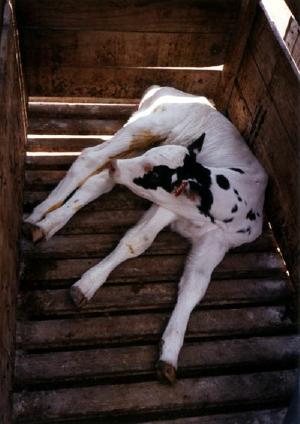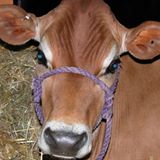VEAL CALVES
Veal is a by-product of the dairy industry. In order for dairy cows to
produce milk, they must be impregnated & give birth. Half of the calves
born are female, & they are used to replace older cows in the milking
herd. The other half are male, & because they are of no use to the dairy
industry, most are used for beef or veal.
Immediately after birth, male calves born on dairies are taken from their
mothers & transported by trucks to be sold through auction rings. These
baby calves are stressed from being taken from their mothers and from being
transported. They are mishandled and when they can no longer walk, they are
dragged by their legs or even by their ears.
Annually one million calves are confined in crates measuring just two feet
wide. The calves are chained by the neck to restrict all movement, making it
is impossible for them to turn around, stretch, or lie down comfortably.
This restricted movement renders the calves' meat "tender" by not allowing
the animals' muscles to develop.

Indications are that calves confined in crates experience "chronic stress" &
require more medication than calves living in more spacious conditions,
thereby making veal the most likely meat to contain drug residues which pose
a threat to human health. It is also reported that this confinement results
in frustration exhibited by head tossing, head shaking, kicking, scratching,
& stereotypical chewing behavior. Confined calves also experience leg &
joint disorders & an impaired ability to walk.
Veal producers feed the calves an all liquid milk-substitute deficient in
iron & fiber in order to produce borderline anemia & the pale colored flesh
fancied by 'gourmets'. At approximately sixteen weeks of age, these calves
are slaughtered and sold as "white" veal (also known as "fancy," "milk-fed,"
"special fed," and "formula fed" veal).

